Medical transcription has come a long way … like, a seriously long way since its inception. So, at ScriberJoy, we’ve been lucky enough to see this wild evolution of an essential healthcare practice firsthand.
We’ve gone from scribbled notes to machines that think they’re doctors—AI-powered systems—highlighting just how much tech has shaken up healthcare. This post? It’s your guide through the biggest moments that have defined this field, providing a peek into where it’s been, where it is now, and where it’s skyrocketing in the future.
From Quill to Keyboard: The Birth of Medical Transcription
The Era of Paper and Ink
Ah, the good old days… or were they? Way back when, medical documentation was about as efficient as a horse-drawn carriage in a Formula 1 race. Docs and nurses scribbled away in hieroglyphic-uh, I mean, handwriting. The result? A breeding ground for misinterpretation and a recipe for paper mountain record retrieval nightmares.
The Shift to Dictation
Then, boom-the swinging ’60s. Hospitals grew, patient numbers exploded, and suddenly, it was clear: organization wasn’t just a luxury-it was a necessity. Enter dictation. Doctors started talking into tape recorders, which, surprise, surprise, made things make a bit more sense. But someone still had to slog through the manual transcription. Baby steps, right?
Portable Dictation Devices Revolutionize the Field
Fast-forward to the ’70s-it’s disco and dictation devices. These nifty machines let docs chat about patient info on the go. Staff would later tackle the transcription, cutting the paperwork time in half… make that quarters. More time treating humans, less time deciphering doctor-sprawl.
The Rise of Professional Medical Transcriptionists
Accuracy became the name of the game, and who ya gonna call? Professional transcriptionists! Cue the American Association for Medical Transcription in 1978, standardizing practices and rolling out certifications. And just like that, you had speed and precision in your medical records-a rare duo before the pros took over.
The Dawn of Digital Documentation
Enter the 1980s-with big hair and even bigger tech leaps. Word processors turned the game upside down, giving transcriptionists a way to edit and stash documents electronically. It was the dawn of the digital revolution in medical record-keeping.
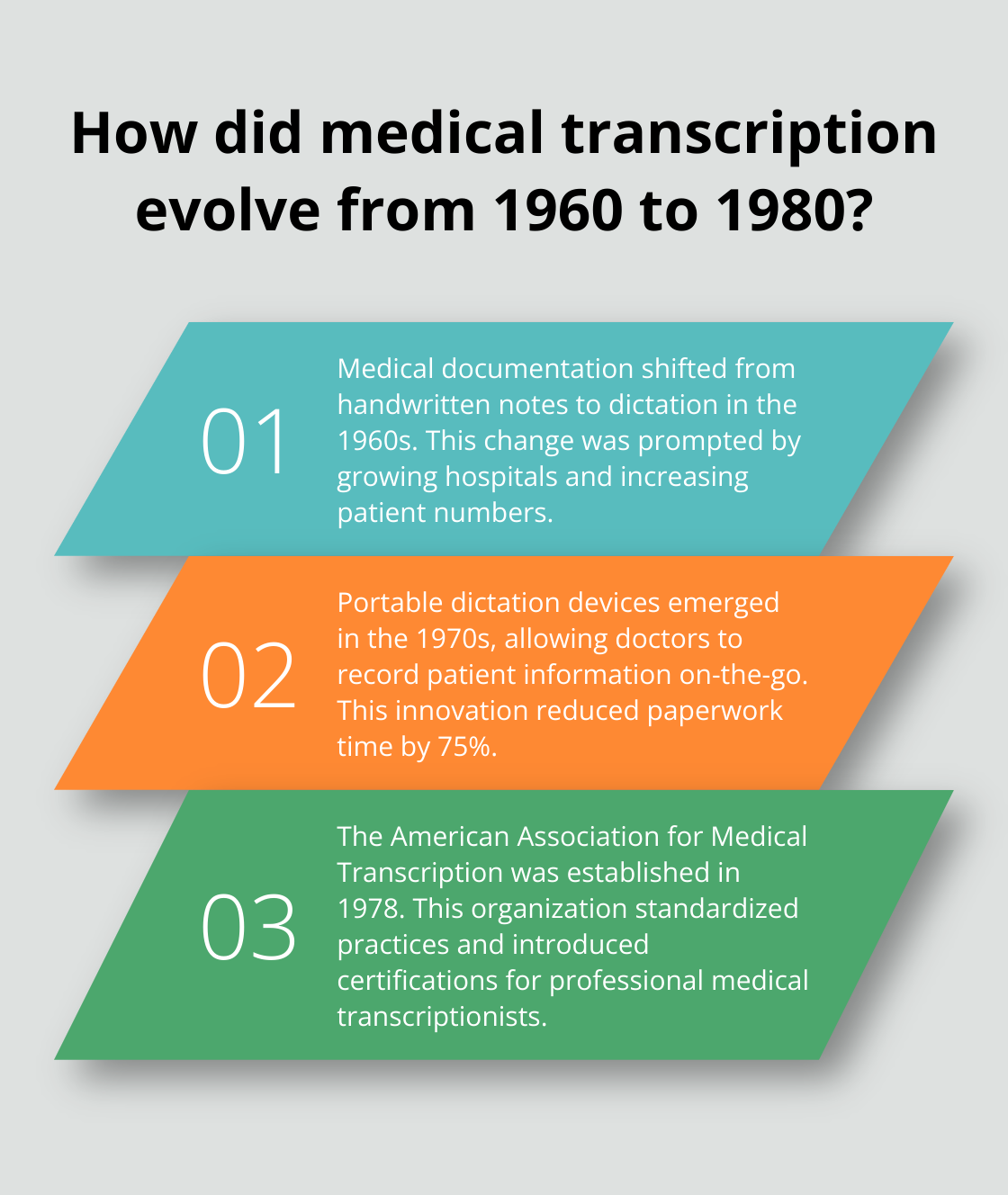
Tracing the path from doctor scribbles to certified transcription superstars paved the road to today’s tech-savvy systems. Sure, AI has taken it to a new level-efficiency on steroids-but it all stands on the shoulders of those initial strides. Next up? We dive into how mind-blowing advances (hello, digital audio and speech recognition) took the transcription world by storm, moving us ever closer to the future of medical documentation.
How Tech Transformed Medical Transcription
The ’90s and early ’00s – a wild ride for medical transcription. We swapped clunky cassette tapes for shiny digital audio, flipping the whole script on how healthcare captures patient info. But this wasn’t just about saying goodbye to tapes; it cracked open a whole new world for working remotely and dialing up efficiency.
Digital Audio: A Game-Changer for Accuracy
Digital audio came along like a boss – clear as a bell and a real bruiser against errors born from muddled, scratchy sound. Now, transcriptionists? They could pause, rewind, tweak playback speeds…all without chewing up those ancient tapes. Talk about turbocharging turnaround times and cranking up accuracy like never before.
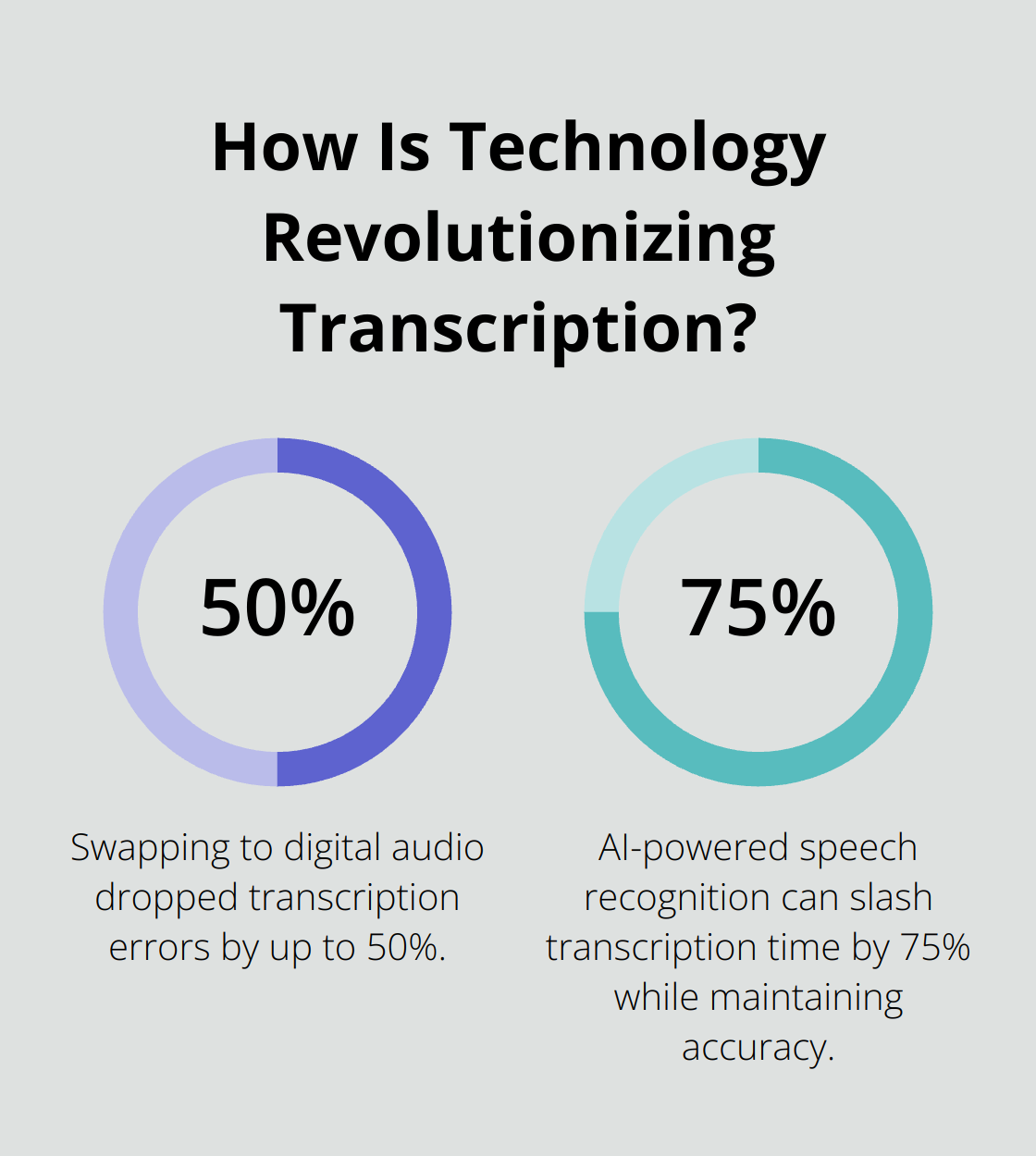
According to the Journal of the American Medical Informatics Association, swapping to digital dropped transcription errors by up to 50%. That’s not peanuts – it’s a giant leap for patient safety and quality of care.
Speech Recognition: The AI Assistant
Fast forward to the 2000s…and boom, speech recognition software starts making a racket. Early days were bumpy – think baby giraffe taking its first steps – but they laid the groundwork for today’s sleek systems.
Now, AI-powered speech recognition is holding down the fort in medical transcription land. Perfect? Nope. Accents, jargon, background buzz – still tripping it up. But, buddy it up with human oversight, and you’ve got a transcription beast. This tech can slash transcription time by a whopping 75% while keeping a tight grip on accuracy.
EHRs: Connecting the Dots
And then we have Electronic Health Records (EHRs), busting on the scene late 2000s, early 2010s…and completing the puzzle. Transcribed notes morphed-from lonely islands to pieces of a cohesive digital patient record.
Workflow? Streamlined, big time. According to a 2019 study in the Journal of Medical Internet Research, EHR-integrated transcription chopped down documentation time for docs – 78 minutes a day, on average. That’s over an hour back in the care game.
But it wasn’t all smooth sailing. Docs initially grumbled – systems felt clunky, a time-suck. Yet, these hurdles opened doors for tech that smooths the EHR bumpier paths, crafting easier, time-saving documentation magic.
So, yeah, the tech saga in medical transcription has flipped the healthcare documentation game on its head. From fuzzy tapes to AI-boosted, EHR-integrated whizzbang systems, accuracy and efficiency have taken huge strides. Peering into the crystal ball? The role of AI in medical transcription is only going up, skyrocketing toward more mind-blowing breakthroughs.
AI Revolutionizes Medical Transcription
Natural Language Processing Breaks New Ground
So… what are we looking at here? AI is shaking things up big time in the realm of medical transcription, reshaping how docs record patient info. At the heart of this seismic shift is Natural Language Processing (NLP), a tech marvel that gets our chatter, no matter how medical-jargon-laden it is. From its baby steps in the 1960s to its rock star status now, AI’s taken healthcare places few dared to dream.
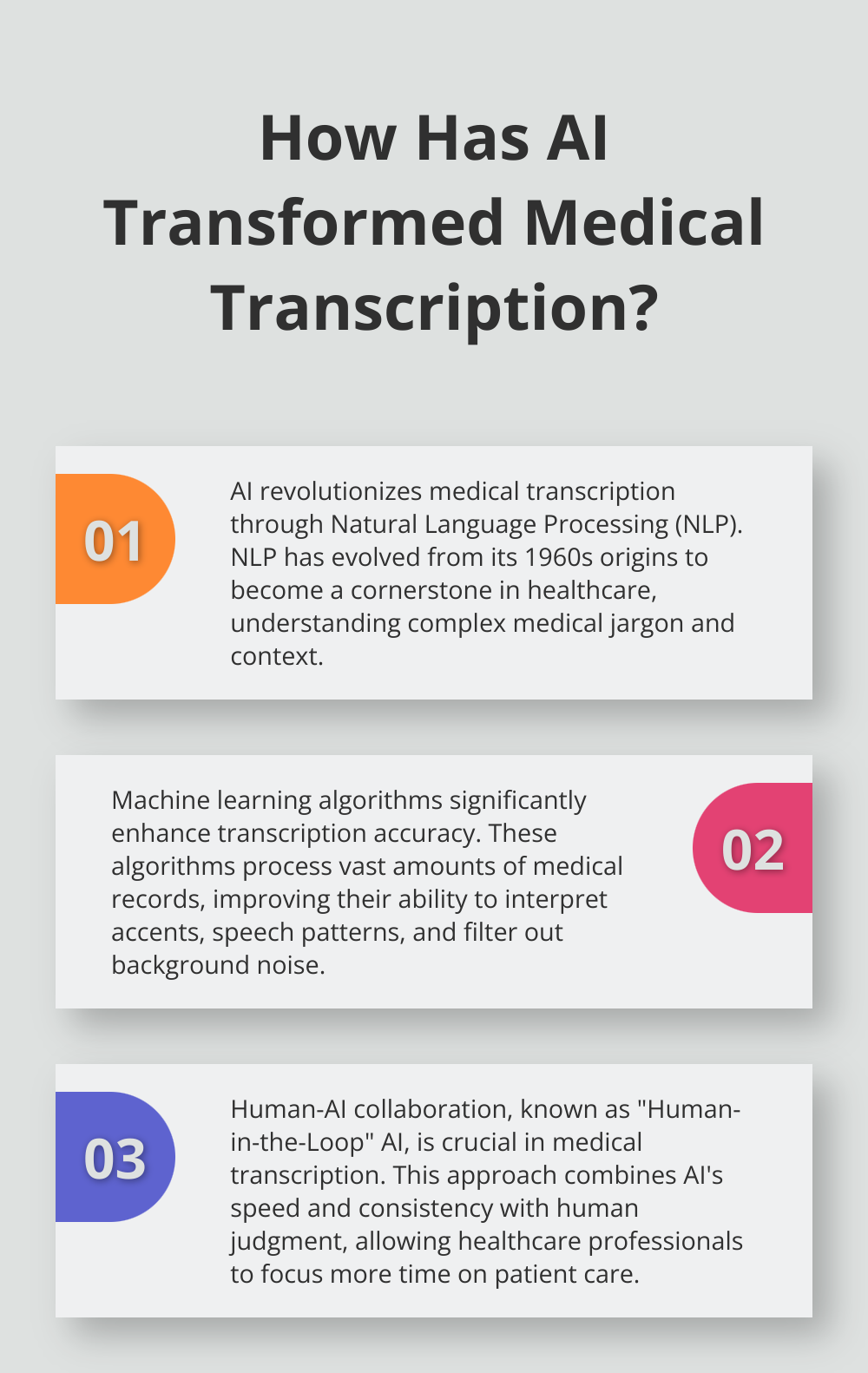
NLP isn’t just scribbling down what it hears; it’s actually got brains… it gets the context. Picture this: telling the difference between “patient” (waiting forever at the doc’s) and “patient” (oh, you’re so calm). That’s the magic of contextual smarts-minimizing those cringe-worthy errors that could snowball into misdiagnosis or worse.
Machine Learning Algorithms Boost Accuracy
But here’s the twist-machine learning algorithms are upping the transcription game like never before. These little Einsteins gobble up troves of medical records and just keep getting better. Healthcare AI isn’t just a one-trick pony anymore; it’s involved in everything from jotting down patient histories to peeking inside for imaging.
These whiz kids of algorithms? They’re champs at decoding accents, handling different speech quirks, and even drowning out hectic hospital noises. Plus, they’re the safety net, flagging any iffy data for human double-checking. That added protection is gold.
The Power of Human-AI Collaboration
Still, let’s not get carried away with the sci-fi vibes. At the end of the day, we still need the human touch in medical transcription. The real magic show happens when you mix AI’s rapid-fire consistency with human judgment. Industry folks have a catchy term for this-“Human-in-the-Loop” AI. You know what? It just works.
For healthcare pros running this collaborative tango, time saved is time gained. More hours to focus on the real MVPs… the patients.
Customization and Adaptability
And let’s talk customization-modern AI transcription systems are like finely tailored suits. They’re molded to fit specific medical fields, physician habits, and those quirky institutional requests. The output? Spot-on, everytime.
Future Prospects
Looking ahead-it only gets wilder. With AI playing nice with other up-and-coming tech, the sky’s the limit for transcription advancements. Brace yourselves for a flood of precision-level medical transcriptions in the not-too-distant future.
Final Thoughts
Medical transcription history-what a ride. We’ve gone from scribbling notes like cavemen to wielding AI-powered systems in our healthcare arsenals. It’s been a wild evolution. Remember the 1960s? That’s when those nifty dictation devices showed up and kicked off the age of professional transcriptionists and digital audio recordings. Major shift.
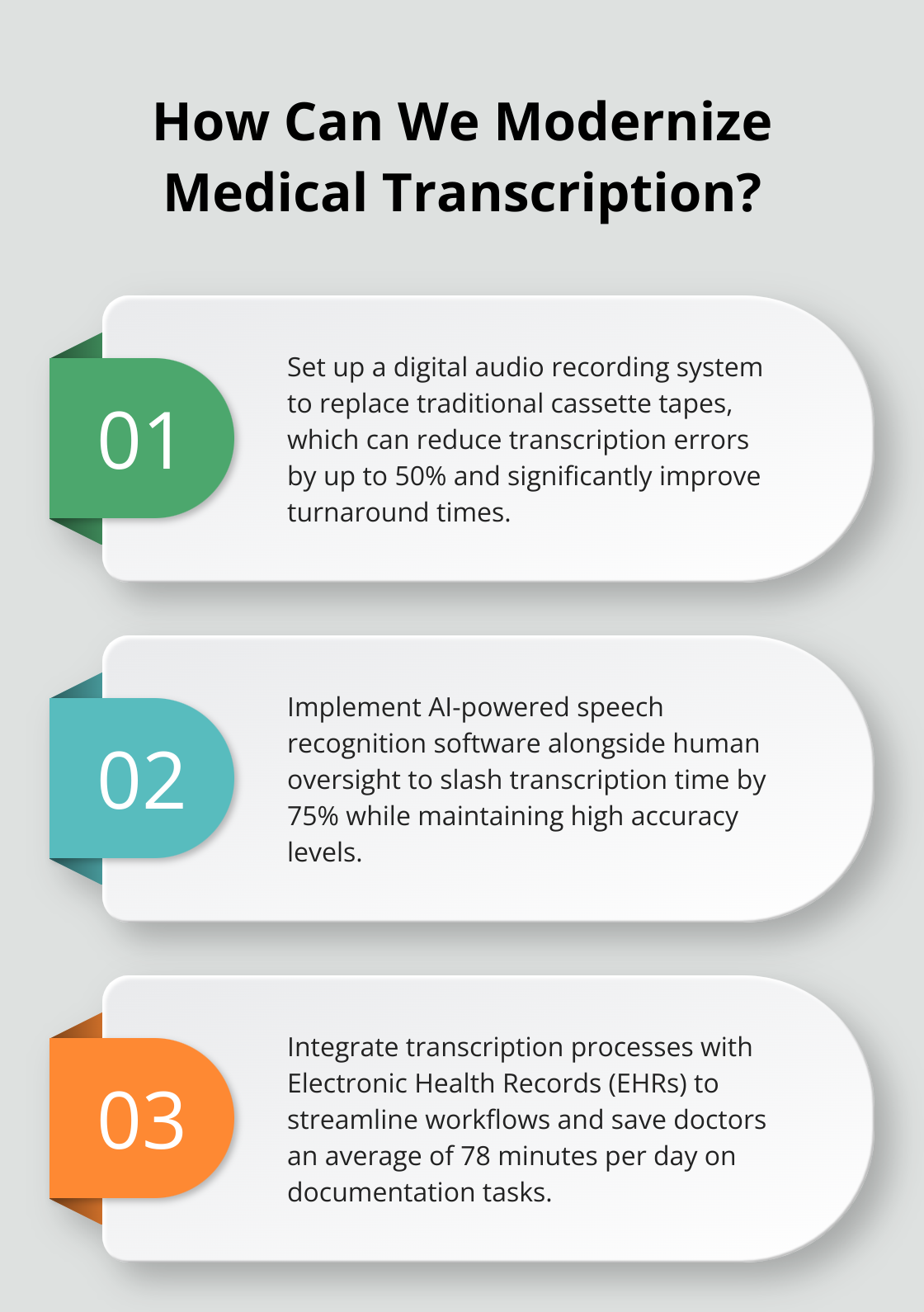
Fast forward to today, and it’s a whole new ballgame. AI and machine learning are now tagging in with human experts to churn out documents with insane accuracy. NLP (Natural Language Processing for the cool crowd) has notched up the game, letting us decode all that complex medical jargon like pros. And don’t even get me started on how syncing transcription services with Electronic Health Records is greasing the wheels, making healthcare way more efficient.
Oh, and let’s talk about ScriberJoy. They’re killing it at the cutting edge, offering AI-powered transcription with a human touch. Helping healthcare folks ditch the paper chase and get back to doing what they do best-caring for patients. As we march on, the blend of human know-how and AI smarts is set to redefine the future of medical transcription. Game on.
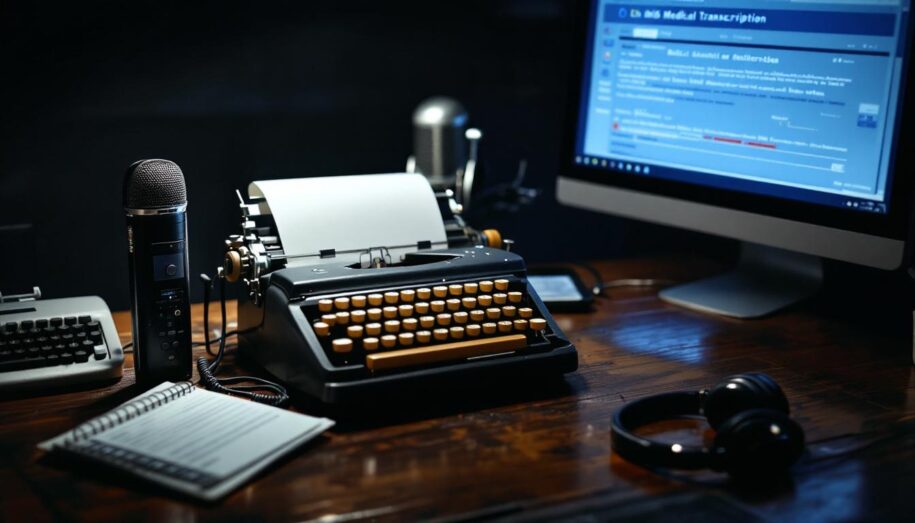
Leave a Reply
You must be logged in to post a comment.